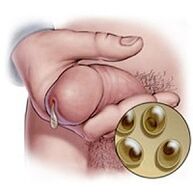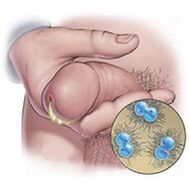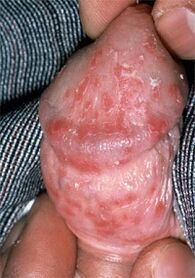
Male genital secretions are the secretions of the urethra (urethra) and the foreskin glands, which are located on the head of the penis, under the foreskin. The ejaculatory duct, prostate duct, urethra, and bulbar urethral glands lead to the urethra.
In healthy men, only urine and semen flow through the urethra. This is a physiological secretion from the penis and should not cause any discomfort. Unfortunately, this is not always the case.
For various reasons, men’s physical condition is trembling, not normal secretions, but abnormal secretions or changes in urine and semen
Variants of physiological secretions
The standard of normal secretion corresponding to the function of genitourinary system organs:
- Urine-clear, from straw to golden yellow, almost odorless, without flakes or other inclusions;
- The secret of the prostate has a thick consistency and a white hue, and a special smell of spermine;
- Ejaculation: Sperm from the ejaculatory duct is mixed with the secretions of Littre gland (urethra), Cooper gland (urethra) and prostate secretion, showing off-white color and mucus consistency;
- Fresh smegma from the foreskin glands is like a thick layer of white grease; it may turn yellow or green over time.
Foreskin lubricant-smegma-is continuously released and accumulates under the lining of the foreskin and in the coronal groove of the penis. The lubricant is composed of fat and bacterial residues and is evenly distributed to reduce friction between the foreskin and the skin of the glans. The maximum activity of the foreskin gland is inherent in adolescence; with age, the secretion decreases and stops completely in old age.
If you ignore the rules of personal hygiene, smegma can accumulate under the folds of the foreskin. In this case, the fat part of the lubricant is oxidized, the protein part is decomposed (actually rot), the clumps turn green and give off an unpleasant smell. The same process occurs on the phimosis. Due to the fusion of the foreskin, it is impossible for the head of the penis to completely detach from the skin folds and remove smegma. The accumulation and decomposition of lubricants can cause chronic balanitis and balanitis (foreskin and balanitis), increasing the risk of cancer.
Urethral discharge, discharge of colorless mucus from the urethral bulb and urethral glands. The discharge data appears in aroused men related to sexual desire. The excretion of clear mucus aims to lubricate the urethra and improve the passage of semen. The amount of secretion varies from minute to abundant, and these parameters are related to the individual characteristics of the organism and the frequency of sexual activity. After a long period of abstinence, the amount of secretions increases.
Contamination is the spontaneous release of sperm and has nothing to do with sexual intercourse. It usually appears when testosterone levels rise in the morning. Depends on the age and intensity of sexual activity: it appears in adolescent boys, adult men-irregular or rare intercourse.
Prostatic fluid, a small amount of transparent mucus with off-white inclusions is discharged from the urethra. It occurs after abdominal muscle tension (for example, constipation) or after urination. The secret includes a mixture of semen and prostate secretions. The increase in volume and opacity may be a sign of prostatitis.
Pathological secretions
In men, the cause of penile secretions may be venereal diseases, tumors, non-specific inflammation of the genitourinary organs, various injuries, medical operations or surgery.
Pathological secretions of the urethra are different from normal:
- According to the quantity (too much or too little, may be moderate);
- Color and transparency (from white to yellow-green, turbidity);
- Passing impurities (blood, pus, mucus clumps);
- Consistency (very thin or too thick and sticky);
- Through the smell (acid, rot, fishy);
- According to the frequency of occurrence (depending on the time of day, continuous or occasional discharge);
- It is related to urination, sexual arousal, drinking, spicy and spicy food.
The nature of the secretions depends on the pathogen of the disease, the state of the immune system, the accompanying disease, and the severity and duration of inflammation (acute or chronic).
If the amount, density or color of the secretions change, if there is an unpleasant odor, it is recommended to consult a doctor and perform an examination. Self-diagnosis is not worthwhile. It is difficult to correctly identify the disease based on only one symptom.
Penile secretions related to STDs

Mucus: transparent secretion, thick and small in quantity, seen in the chronic form of chlamydia, mycoplasma or urethritis. Microscopic examination revealed a moderate number of white blood cells in the secretions (the standard is a maximum of 4 cells per field of view).
Mucopurulent: white discharge, translucent; observed in the exacerbation stage of chlamydia, ureaplasmosis and mycoplasmosis. In chlamydia infections, they accumulate on the head of the penis, just like "sticking" to the skin.
For the above conditions, the excrement will come from the urethra itself, because microorganisms will irritate the mucous membrane of the urethra and the body will try to "wash it off".
The whitish secret seems to cover his head. This is related to chlamydia and candidiasis. In the first case, a thin film is formed, in the second case-loose tacky blooms.

Purulent discharge with an unpleasant smell is characteristic of gonorrhea. They are sticky, sticky, yellow or light green, and have a rotten smell. Microscopic examination of the material revealed epithelial cells from the urethra, many white blood cells.
Symptoms that accompany gonorrheal urethritis: persistent large secretions; pain, itching, and burning sensation during urination are particularly severe.
In sexually transmitted diseases, co-infection is often observed, and several pathogens are combined at the same time. Gonorrhea and trichomoniasis are accompanied by chlamydia, and mycoplasma and ureaplasma usually appear in pairs. The symptoms of this type of disease are different from the classic manifestations; urethral secretions can also have completely different characteristics. Therefore, for the final diagnosis, highly reliable modern analysis techniques are used instead of discharge characteristics.
Non-specific (non-venere) inflammation
The cause of non-specific inflammation is its own microbial community, which is a conditional pathogenic bacteria, which can only be activated when the body's immune defenses have problems. Streptococcus and Staphylococcus, Candida fungi and Escherichia coli always exist on the surface of the skin and mucous membranes, but after low temperature, long-term stress, uncontrolled antibiotic treatment, and radiotherapy, they begin to actively multiply and replace beneficial bacteria and chemotherapy.
Non-gonorrhea (non-specific) urethritis. Inflammatory secretions are small in size and can be seen in the urine as mucopurulent bands or bumps that appear in the initial stages of the disease. The symptoms of burning and itching during urination are not as pronounced as gonorrhea, but this urge is frequent and does not bring relief. For ascending infections, the bladder first becomes inflamed, then the ureters and kidneys; there is a secretion mixed with scarlet blood.

Candidiasis (thrush), fungal urinary tract infection. It usually develops under the background of suppression of the immune system after a course of antibiotics, chemotherapy or radiotherapy; sexual transmission of male candidiasis is rare. Thrush is characterized by sour clot discharge, itching and burning during urination (urination) and ejaculation (ejaculation), and may be accompanied by dull pain in the groin, upper pubic bone, and lower back.
Gardnerellosis of the urethra. The fishy smell of the discharge is characteristic; they are scarce, yellowish white or green in color. According to certain classifications, Gardnerella is called a venereal disease, but in men, Gardnerella sexual infection is more likely to be a kind of curiosity. In fact, this disease is related to the violation of the normal microbial community, which is related to ecological disorders. In its treatment, immune correctors and probiotics (lactic acid bacteria) must be used.
Balanosis, inflammation of the foreskin. A large amount of purulent discharge was observed locally, possibly mixed with mucus. It is always accompanied by edema and congestion (redness) of the foreskin leaves, and soreness of the head of the penis.
With prostatitis, cloudy secretions appear at the end of urination, large secretions-in the acute phase of inflammation; sparse and white-as the disease turns into a chronic form. Prostatitis is usually accompanied by dysuria and erectile weakness, in severe cases-up to anuria (completely no urine flow) and impotence.
Discharge has nothing to do with inflammation

Nocturnal emission-Excreted in the form of passively flowing sperm, occurs outside of sexual intercourse or masturbation, without the feeling of orgasm. The reasons are some neurological diseases, spinal injuries, chronic stress and any long-term inflammation of the genital area. Nocturnal emission is related to the invasion of innervation and the decreased tension of the vas deferens.
Bleeding, spots. Urethral injury often occurs during Bugigan surgery, after insertion of a catheter, or when smearing from the mucosa. In these cases, the blood is fresh, there are no clots, the amount is small, and the bleeding is rapid. When small kidney stones or sand disappear, blood is released during or immediately after urination, and bleeding is accompanied by very severe pain (renal colic). The blood discharge of glomerulonephritis (inflammation of the glomeruli) in the form of hematuria is combined with edema and persistent high blood pressure, and protein appears in the urine.
The discharge is brown, with blood clots or mucus, mixed with pus, and appears in malignant tumors of the prostate, urethra, or bladder. Brown mucus can be formed during mucosal wound healing and is secreted with polyposis of the urethra and/or bladder.
Prostatic fluid is the secretion of the prostate from the urethra. It occurs in chronic prostatitis, prostate adenoma, and impaired innervation (neurogenic bladder).
Inspection algorithm when pathological penile secretions are present

- Check the perineum, penis, foreskin and glans. The goal is to identify deformities, signs of injury, signs of external inflammation, secretions, rashes, etc. of the reproductive organs. Sometimes traces of secretions can be seen on the linen.
- Palpate the inguinal lymph nodes to assess their condition: size, they are hotter or colder than the surrounding tissues, whether they are painful, soft or dense, movable or adherent to the skin, and whether there are ulcers above them.
- Prostate finger examination; massage the prostate through the rectum and obtain secretions for microscopic examination. It is best not to urinate within 1-2 hours before the massage. In the case of a prostate adenoma, the lobes increase roughly the same, and dense strands can be felt. For malignant tumors, uneven growth and consistency are typical; during prostate palpation, clotted blood can be released from the urethra.
- Materials-Smears for microscopy and culture. When examined under a microscope, the stained smear showed blood cells, epithelial cells, sperm, fat content, and some pathogens (E. coli, Neisseria gonorrhoeae, Gardnerella, yeast). An increase in the number of white blood cells is a characteristic of acute urethritis or worsening of chronic inflammation, and eosinophils-for allergic urethritis. Red blood cells are found in severe inflammation, tumors, urogenital damage, and urolithiasis. A large number of epithelium is a sign of chronic urethritis and urethral leukoplakia. For spermatorrhea, sperm cells are found in the smear, with urethra-mucus, prostatic fluid-lipid particles. For the reliability of information content and results, smears should be performed no earlier than 3 days after topical application of antibiotics, antifungal agents, and disinfectants. If antibiotic treatment is systemic, then at least 3 weeks should elapse after the course of treatment. Do not wash before smearing, try not to urinate within 2-3 hours.
- General clinical analysis of blood, blood sugar for blood-in the morning, on an empty stomach. Expanded urinalysis (morning part, immediately after sleep).
- Ultrasound examination of prostate, bladder and kidney; CT and urography.
If the signs of genital inflammation are strong, then before the test results are obtained, immediately prescribe a broad-spectrum antibiotic to the patient. In case of heavy bleeding, hospitalization is required and active measures are taken to stop the bleeding. The suspected malignant tumor can only be confirmed by a biopsy, and the final diagnosis is made on the basis of histological examination.
important:
- Penile discharge is only a symptom that cannot be guided at the time of diagnosis.
- The independent appointment of the farm is unacceptable. Drugs, even for the manifestations of specific diseases, seem obvious.

























